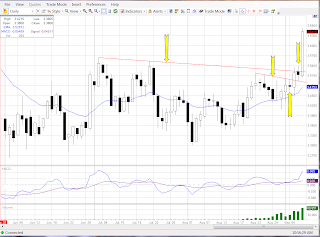I wanted to post a bit on trading breakouts. In particular, I want to provide my thoughts on what happens the day after a breakout. Keep in mind that I am writing in reference to the Taylor Trading Technique, and Linda Raschke's writings (especially Street Smarts). According to Raschke, in an appendix of my copy of The Taylor Trading Technique by Trader's Press, she says that Taylor says to skip the first buy day, when price is breaking down from a congestion area. I am also looking at this when price is breaking up, as well. I have not yet found this in Taylor's writing, but let's assume that he did state this.
In one of her articles, Raschke mentions that she skips the first buy or sell swing at the start of a trend, often caused by- an NR7 bar (usually preceding a breakout), 3 small range days (consolidation), the point of a wedge (also consolidation), a breakaway gap, or a rising ADX. The point here is that a move out of congestion or consolidation is often the start of a new trend, or a continuation of a trend, with the consolidation portion being a pause in the trend. This can be seen on a bar by bar basis, as often after a strong breakout bar, there is a consolidation bar, many times a narrow range day, or chop that forms a doji bar. On an intra-day chart, this shows as consolidation.
Below are some charts that show this, starting with Friday's E mini future.
A consolidation can be clearly seen as a descending triangle, with support at the 20 day ema. Friday showed a big breakout, closing at the highs of the day. I got tricked into looking for a SS day after the breakout, but neglected to view things within the larger context of the uptrend, and fact that the b/o day was likely the resumption of that trend out of consolidation.
For a couple of more examples, see the below chart of Crude oil-
Notice the first congestion area. looking like a small box. The breakout bar clears the 20 day ema, possibly signaling the upturn of trend. the bar following tests the ma, but regains it- not a good SS day, but rather, a pause before the next up bar. The price trend then consolidates into a descending triangle at the ema, then moves out of it on high volume. the bar after the b/o bar is a z day, you would not be wise to short it.
Here is a recent example of Copper-
The first breakout moves out of a small triangle that is within a larger pattern. The upper trend line serves as good point for setting a profit target. Note that price broke out following a narrow range doji bar, then formed another consolidation bar just below the upper trend line (just like the bar preceding the first b/o). This first move is part of a First Cross pattern that Raschke writes about often. It is often the second wave of a three wave a-b-c trend move.
Friday brought another breakout, due to the China announcement of more easing. Thursday's day after the b/o could have been traded as a SS day, but the lesson here is to trade the post b/o days carefully, especially if they seem to be indicating a change of trend.
Finally, take a look at the multiple breakouts in this chart of gold futures. See the small and larger triangle breakouts, and note that the b/o bar has increased volume compared to the day before. The third b/o is from a small bull flag, a consolidation pattern. The last b/o is very interesting. Thursday, price broke out of a pattern of three small range days (mentioned above), but closed weakly. It did close above Tuesday's high, and the sell off Friday morning may have well sucked in a lot of shorts before reversing. The lesson is to be careful shorting right after a breakout from consolidation.
Use this tendency to stay safe, and perhaps use as a criteria for holding onto a b/o bar for more than just the one day. All of that said, there does seem to be good reason to short after a breakout, when the trend is NOT changing, but I will post regarding that, at another time.



